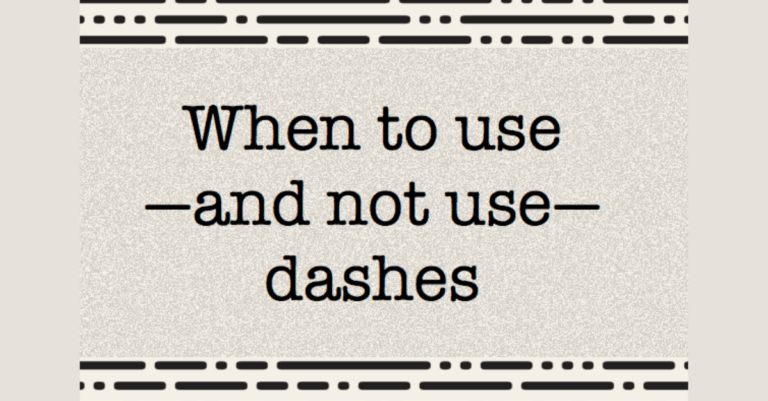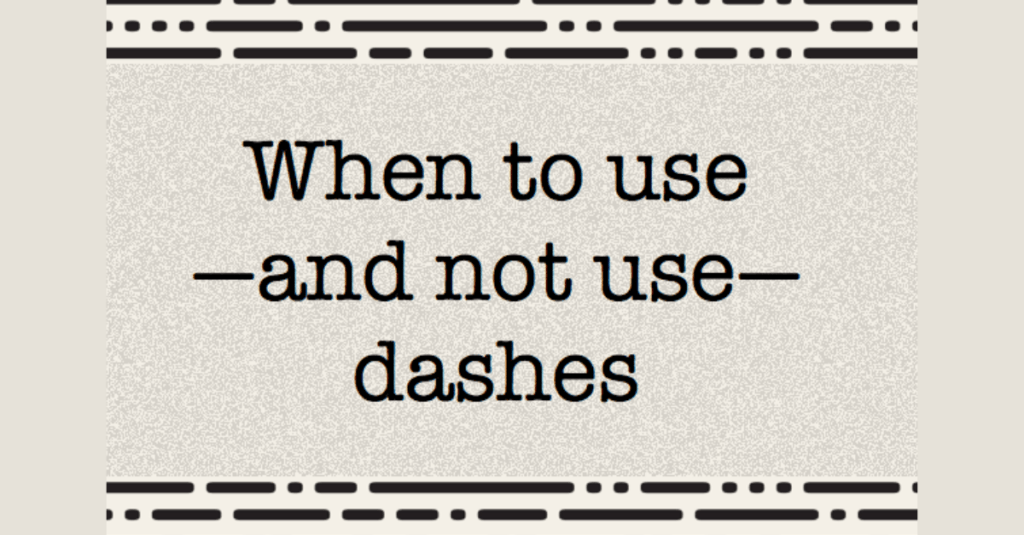When people think of punctuation marks, it is usually the handy comma, the imperious colon, or the overly excited exclamation mark that comes to mind. The stodgy semicolon and sinuous question mark might get thrown into the mix, but rarely—if ever—will somebody mention a punctuation mark that, while omnipresent, often goes unnoticed. This is surprising considering that this punctuation mark is highly versatile and a favorite of skilled writers. It can add a spice—or a dash, if you will—to a sentence by adding emphasis to certain words and phrases.
I am talking about the em-dash, which looks like two hyphens connected into one long line. Depending on the sentence, the em-dash can have a similar function to parentheses, colons, commas, and even semicolons. But an em-dash is not the same as these other marks; it brings a different flavor to the sentence and adds a special emphasis that wasn’t there before.
To show how to wield this handy punctuation mark, I’ll start by comparing two sentences: one that contains an em-dash (or em-dashes) and one that contains another punctuation mark. I’ll begin with parentheses, then discuss commas, move on to a semicolon, and finally end with a colon.
Lastly, I’ll touch on how to avoid overusing or misusing the em-dash—which can become tempting once you learn its many uses.
- 1. Parentheses and the Em-dash
- So, let’s start with parentheses versus em-dash, by comparing two sentences.
- Dennis took his car (a tiny, two-door Honda) on a weekend road trip.
- Dennis stuffed his four best friends into his car—a tiny, two-door Honda—for a weekend road trip.
- In the first sentence, the fact that he has a small Honda doesn’t seem that closely connected to the fact that he took a road trip. Since we don’t want to bring too much attention to this information, we keep this information in parentheses. But in the second sentence, the size of the Honda is relevant to the road trip. Now he is “stuffing” four other friends into this small car. We use em-dashes to add emphasis to the size of the car.
- It’s also important that when you set off a phrase using em-dashes that you used one em-dash immediately after the noun the phrase is describing and one immediately after the phrase. Don’t replace the second em-dash (as some tend to) with a comma or semicolon.
- Identifying how an em-dash is used and actually using one in your own writing are two different things, the latter being trickier. Here’s a good strategy to use when trying to decide whether to use em-dashes or parentheses in your writing: If you find yourself wanting to throw in a little extra information about a noun in a particular sentence and are not sure whether the parentheses or the em-dash is the way to go, read the sentence out loud. When you get to the information contained between the em-dashes, add a little bit of humph as you enunciate each word. Then replace the em-dashes with parentheses and reread the sentence without adding any emphasis to the phrase in parentheses. In theory, that’s how your readers will interpret the sentence in their own minds—more emphasis, or “humph,” with the em-dash, and less with parentheses.
- For instance, let’s say you are writing about a young pianist who mastered the works of composers known for their challenging pieces. You might want to highlight those names. The em-dash allows you to do this.
- Mastering the works of her favorite composers—Rachmaninoff, Brahms, and Chopin—took many diligent years of practice.
- If it sounds odd adding special emphasis to the composers when reading the sentence aloud, then parentheses are better.
2. Em-dashes Instead of Commas
- If you were wondering whether you could have used commas in place of parentheses or em-dashes in the examples above, you can. In terms of adding emphasis to a phrase, the comma falls somewhere between the parentheses and the em-dash. Another thing to keep in mind is that many sentences already have commas so using them to set off a descriptive phrase can make things a little crowded with commas. Let’s revisit our “Dennis road trip” sentence to use as an example.
- Dennis took his car, a tiny, two-door Honda, on a weekend road trip.
- See, lots of commas. An em-dash gives you another option when you are dealing with a phrase that describes or elaborates upon a noun. But again, use it only when it is clear that you want to add emphasis to a phrase.
- For instance, in the sentence below the em-dash highlights an unusual (and unfortunate) fact about this person’s friend:
- Her best friend, indeed her only friend, did not even send her a birthday wish.
- Her best friend—indeed her only friend—did not even send her a birthday wish.
As we saw with parentheses, when an em-dash replaces the commas that set off a phrase, it adds more emphasis. It also gives a writer the opportunity to avoid “comma clutter.”
Em-dashes in Place of a Colon
- Just as em-dashes add emphasis when they take the place of commas or parentheses, so do they add emphasis to an already emphatic punctuation mark: the colon. You want to be sparing in your use of an em-dash in place of a colon, and remember that by using an em-dash instead of a colon, your style becomes less formal. If that’s your intention and you want to add special emphasis to a word or phrase, then use the em-dash. Take the following sentence as an example.
- After 1,000 miles of sputtering along in his tiny Honda, Dennis could think only one thing as he approached his driveway—home.
- Of course, you could use a colon in this sentence, but the em-dash gives it an extra dramatic flair.
3. Em-dashes in Place of a Semicolon
- I wasn’t exaggerating when I said the em-dash was versatile—it can even take the place of the semicolon. Once again, the em-dash adds more emphasis than the traditional punctuation mark. To illustrate, I’m going to reproduce the first sentence of this paragraph, but with a semicolon:
- I wasn’t exaggerating when I said the em-dash was versatile; it can even take the place of the semicolon.
- It’s up to you, but remember: Making a choice that is more apt—the semicolon is already a difficult piece of punctuation to navigate—will show off your skills as a writer.
Misusing the Em-dash
- At the same time, if you start using em-dashes throughout a text to emphasize all your thoughts, the dashes start to lose their power. And your writing will come across like one of those amateur actors who dramatizes every single line he delivers—heavy-handed.
- Another way to overuse em-dashes is by using them whenever a semicolon, colon, or parentheses show up. One mark of good writing is the discerning choices the author makes in punctuation. Defaulting to the em-dash suggests you haven’t really thought through why you used the mark in the first place. It also makes your writing look full of dashes, which can confuse the reader. That professional writers—mostly—know how not to overuse em-dashes might account for why we tend to overlook them. A good rule of thumb: try not to use them more than twice per paragraph.
- Finally, level of formality is huge. If you are writing fiction or using casual language (like an email to a close colleague), em-dashes work well. But if you are applying for a job or asking for a letter of recommendation, you want to be careful in your use of the em-dash. Yet even in these more formal contexts, a well-deployed em-dash can give your writing a dash of sophistication.
- —-
About the Author
Chris Lele is the GRE and SAT Curriculum Manager (and vocabulary wizard) at Magoosh Online Test Prep. In his time at Magoosh, he has helped students across the globe dramatically improve on these difficult tests. Some have even gone on to get near perfect scores.
This is the Dear World Instagram post I mentioned in the podcast:





